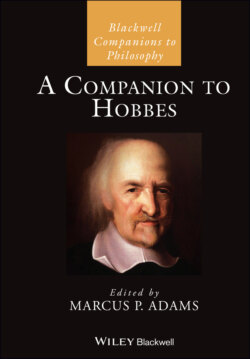Читать книгу A Companion to Hobbes - Группа авторов - Страница 52
Notes
Оглавление1 1 See Scott (1938, chapter 10) and Jesseph (1999, 10–16) for an overview of the many published pieces in the dispute.
2 2 This is not to say that Hobbes’s mathematics has been altogether ignored. See Dunlop (2016), Grant (1996), Jesseph (1999) for treatments of Hobbes’s mathematics. Richard Peters summed up the general scholarly embarrassment at Hobbes’s mathematical work in claiming that “[e]ven when allowance has been made for the fact that squaring the circle did not then seem quite such a preposterous project as it does now, it remains evident that Hobbes’ sublime confidence in his own ability led him to make rather a pathetic exhibition of himself” (1956, 40).
3 3 In particular, the anecdote requires us to suppose that Hobbes was utterly ignorant of geometry even though he was educated at Oxford, where geometry was a required part of the curriculum. Moreover, Aubrey’s story relates the remarkable coincidence that the copy of Euclid that Hobbes came across happened to be open to the Pythagorean Theorem (Elements, Bk I, Prop. 47). Further, even allowing for this coincidence, the Euclidean proof is sufficiently complex that it is essentially unintelligible to a complete geometric novice (as Hobbes allegedly was).
4 4 The passage from the Examinatio (Hobbes 1660, 154) is remarkably close to Aubrey’s account. Bernhardt (1986) examines it in some detail.
5 5 Euclid, Elements, Book I, Postulate 1: “Let the following be postulated: to draw a straight line from any point to any point”.
6 6 See Palmieri (2001) for an account of the definition and the discussions it engendered.
7 7 The actual proof in De corpore 2.13.12 (EW I.156–7) is convoluted enough that it need not detain us; Hobbes in fact shows that his definition of sameness of ratio can be used to derive the Euclidean definition as a consequence.
8 8 See Bos (2001), Jesseph (2016), Mancosu (2008), and Serfati (2005) on the Cartesian program for geometry.
9 9 For an overview of Viète’s approach see Bos (2001, chapter 11). Shirley (1983), and Cajori (1916) give accounts of the contributions of Harriot and Oughtred, respectively.
10 10 See Andersen (1985) and Jesseph (2020) on Cavalieri’s approach.
11 11 See Bascelli (2015) on Torricelli and Julien (2016) on Roberval.
12 12 See Jesseph (2018) for an overview of the dispute.
13 13 Ward was principally concerned with publications by the Puritan radicals John Webster and William Dell. See Debus (1970) for details.
14 14 “I was amazed that you judged [Hobbes] worthy of such a lengthy refutation, although I read your learned and rather sharp Elenchus with some pleasure” (Huygens 1888–1950, 1:392).
15 15 Hobbes writes: “Having full confidence in his demonstrations, he did not doubt that Archimedes thought the same as he. But after having realized that his geometric methods disagreed with the arithmetical methods of Archimedes, which themselves were properly worked out, he undertook (as far as he could) to alter his so as to agree with the calculations of Archimedes. Yet when he could not succeed in this, he struck the whole chapter; and upon taking the matter up again he did not discern that it reduced to the very same numbers before he handed the book over to the printer. And so he at last reduced his demonstration to a mere approximation, out of respect for Archimedes. So far was he from thinking (as his adversaries claim) that learned men of previous centuries have achieved little, that he abandoned truth itself because of their reputation, even as he was on the point of making it public” (Hobbes 1660, 149–50).
